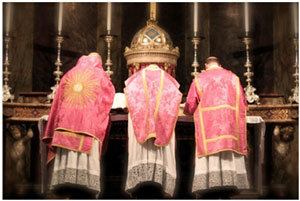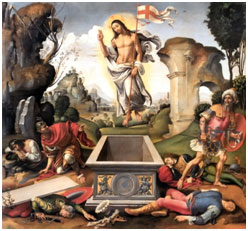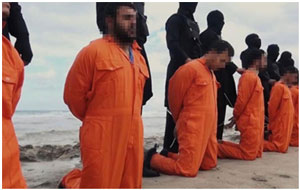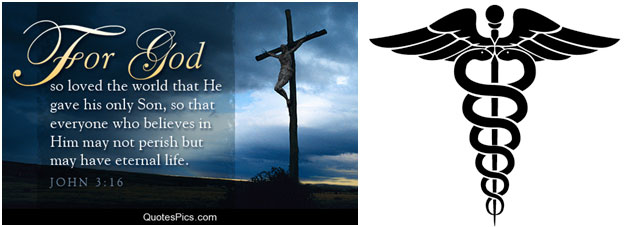Mass of Laetare Sunday

Introduction for the Mass of Laetare Sunday
St Mary’s Cathedral, Sydney, 15 March 2015
Welcome to today’s Solemn Mass at St Mary’s Cathedral. I am especially pleased to acknowledge concelebrating with me today Cardinal George Pell, my immediate predecessor as Archbishop of Sydney, who is having a short but very well-earned break from his duties as Prefect of the Vatican Secretariat for the Economy. A very warm welcome home Your Eminence!
Given all Cardinal Pell’s efforts to restore and beautify the sanctuary of this cathedral, I am pleased that he can be present for the blessing of the recently-installed lamp that marks the presence of Our Lord in our sanctuary. It was generously donated to the Cathedral by Mr Mark Roberts, a great friend of Christ and of this cathedral, whose presence here today I also acknowledge.
Homily for the Mass of Laetare Sunday
St Mary’s Cathedral, Sydney, 15 March 2015
Today is Laetare Sunday. In middle of this penitential season of walking with Christ to Jerusalem, to His Passion and Death, the Church, as it were, breaks out in laughter. It’s almost as if we’re unable to take the dour purple of Lent seriously: the Church is impatient, like a child eyeing Easter eggs, picking them up when no-one is looking, scratching them, sniffing the chocolate. Even our bishops are dressed up like Easter eggs on this day!

http://www.birminghamoratory.org.uk/wp-content/uploads/2013/08/Laetare-1.jpg
Jesus Christ, crucified by us and for us, will rise from the dead, not just to say ner-ner-ner to His persecutors, but to say ner-ner-ner to Death itself – our last enemy – and to Sickness, Ignorance and Sin, Death’s allies and so our enemies too. His ner-ner-ner is proclaimed not just on His behalf but on behalf of us all, for at Easter we will sing that the ‘happy fault’ of Adam’s sin ‘earned so great, so glorious a Redeemer!’ (Exultet) Try as we humans may to extinguish Christ our Light, He emerges from the darkness on Easter night, as enlightenment and hope for us all. Though we regularly prefer hostility, ignorance, sickness and sin, He rises from the tomb offering peace, wisdom, health and holiness. Though we all too often choose mortal sin and so death, yet ‘Hope springs up again’ and eternal life can be ours. Hence the rose-coloured vestments; hence the prayers today that speak of joy in the midst of Lent!

http://www.theanglocatholic.com/wp-content/uploads/2012/04/Resurrection_Raffaelino_del_Garbo_1510.jpg
Not that Christianity looks at the world through rose-tinted glasses – far from it. As the Gospel reminds us: though God came to His own, they did not receive Him; though the Light came into the world, men preferred darkness; though the Word became flesh we lifted Him up on the Cross (Jn 3:14-21).
And there on the cross Christ will be stripped of everything: His divinity, dignity, comfort and success; stripped of His clothes, His friends, His life. For He has entered fully into the human mess of thirst, anguish, isolation, failure; the mess in every family, community, church. So too must His Church in every generation, identifying most closely with those who must carry a cross. So Christianity cannot be a rosy-eyed religion. No, ours is a brutally realistic view of the world. It knows about victims and their suffering, victims of injustice and war, of disability and disease, of depression whether economic or psychological, of loneliness or compulsion, of sinfulness and powerlessness of so many kinds.
Yet amidst all this black and blue, the purple of bruises, true Christians remain optimistic, rosy-hearted as it were. Wowsers take a dim view of the rosy things of the world and the flesh, of Christmas presents and Easter eggs and associated vices such as singing, dancing and smiling; they think being religious means being dour, repressed, censorious and pessimistic. But our faith speaks in a very different language: despondent Israel in our First Reading will be redeemed, the Temple rebuilt, the people returned home (2Chr 36:14-23). Or as Paul said so beautifully in our Epistle: though dead through our sins, we are brought again to life by God’s grace, making us “God’s work of art, created in Christ Jesus to live the good life” (Eph 2:4-10). Each one of you is a work of sacred art – of music, painting, architecture – but in flesh and spirit, made painted or carved or sung by Christ to beautify our universe, inspire our neighbours, give glory to God.
Which seems to bring us to something of an emotional stale-mate: how can we be realistic yet joyful, confident without clowning, purple and rose at the same time? How is it possible, without self-contradiction, without split personality, to be both truthful and jubilant, self-assured without being facile, optimistic without romanticizing? And where is this God who is supposed to want us to be happy if so many people are suffering?
God so loved the world He sent His only Son: to be with us in the mess but to lead us beyond it also. The folly of the Cross will be the moment of Christ’s glorification and our redemption: the ultimate revelation of divine love, of the justice and vindicating power of God’s love; a love that keeps on loving even in the depths of betrayal and murder; a love that meant the recent Coptic martyrs of I.S. could say the name of Jesus as they died; a definitive love that gives itself completely for others rather than focussing on self. The irony of that tree upon which the Son of Man must be lifted up is this: that in the very act of total self-surrender to God and others, of total self-giving for the sake of truth and love, we are given back ourselves and more.

More: “The Son of Man must be lifted up” on the Cross “as Moses in the desert lifted up the serpent” on a stick. Now, a serpent on a cross-shaped stick, we all know, is the symbol of doctors, of medicine, of healing. Christ’s death and rising will be our medicine, for “by His wounds we are healed. In giving ourselves with Christ we are graced to be and do more than we could ever alone. Our Catholic faith and life lifts us up, out of present cares, and gives us back to them with new vision and hope, ready to comfort and confront, open-eyed yet rosy-hearted.

As we celebrate today Laetare Sunday, remember Paul’s call to you to be God’s works of art, made for the good life. In seeing the beauty of your life may others learn that God so loved world He gave His only Son that those who believe should not be lost but may have eternal life!
After Holy Communion: Introduction to the Blessing of the New Sanctuary Lamp
We come now to bless and light our sanctuary lamp. Of eighteenth century French Gothic design, it has been fully restored and now hangs prominently at the entrance to our sanctuary. Its rose-coloured glass will indicate the Real Presence of Christ in the Blessed Sacrament and its rosy light will be a reminder of the great hope and joy that the Catholic Faith offers our world. So it is fittingly blessed and lit on this rose-coloured Laetare Sunday. Jesus gives Himself to us at Calvary in every Mass upon this altar and in that wonderful Sacrament reserved in our tabernacle. Our response is thanksgiving, in Greek åõ×áñéóôåù, from which we get our word Eucharist. We thank God; we also thank Mr Mark Roberts for this gift that adds to the patrimony and magnificence of this cathedral.
Mr Roberts has been a long time friend of St Mary’s. Though illness requires him to soon return home to England he describes this cathedral as his “spiritual home”. He offers this lamp in thanksgiving to the people of Sydney and this Cathedral community, including the former Dean, his friend Monsignor Redden. May Christ’s light shine from here for all the world to see, offering Laetare comfort, joy and peace!

